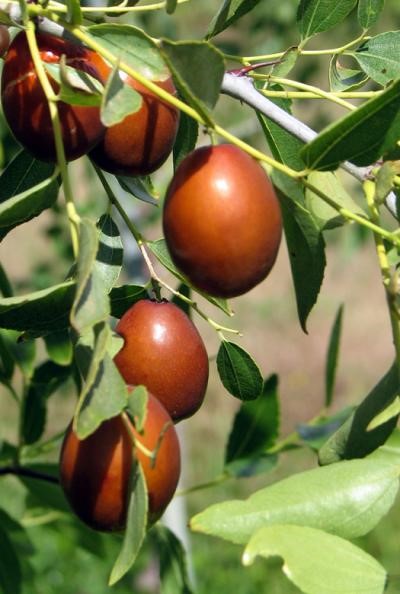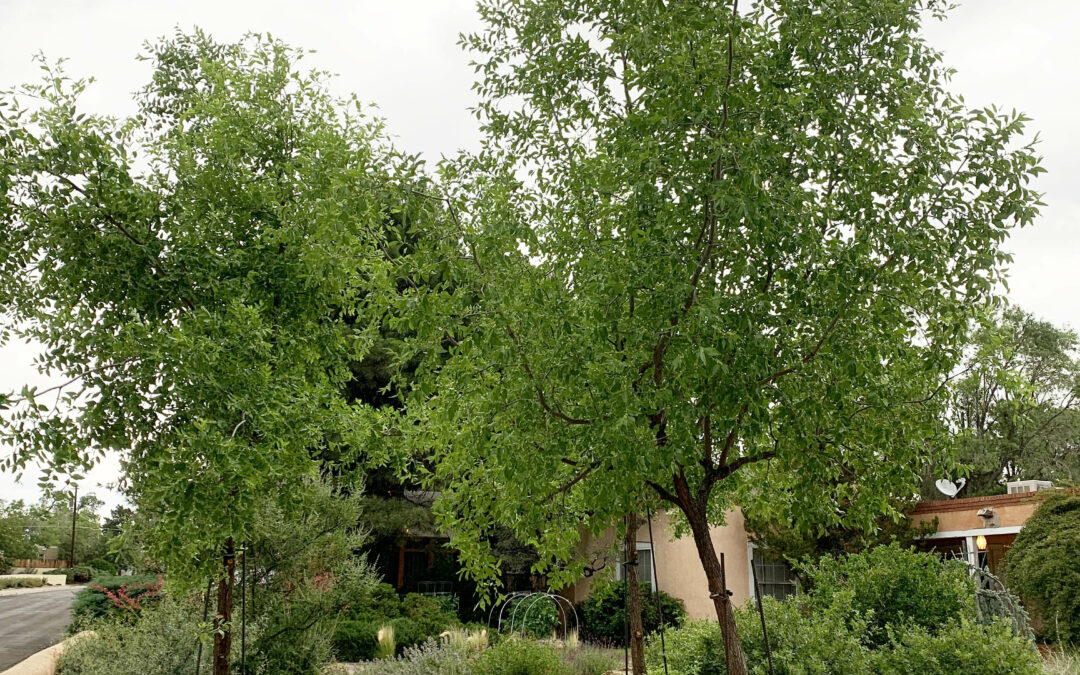The jujube is just one of those trees that is extra! Extra fruitful, extra nutritious, extra hardy, extra beautiful. This medium sized tree comes in 400 varieties, many of which are being cultivated and taking root in Albuquerque.
The jujube tree, often called Chinese date, has been cultivated for thousands of years around the world, in Albuquerque for nearly 60 years and in the panhandle of Texas since 1875. Its small abundant fruits are high in fiber, vitamin C, potassium, antioxidants and phenolic compounds and have been used to support nervous system, cardiac and digestive health. Medicinally, it is used as a tonic sweetener in many supportive Chinese herbal remedies.
The fruit can be eaten raw, dried or cooked. Fresh from the tree, when they’re mature and a luscious mahogany brown, they have a crunchy refreshing taste, like a cross between an apple and a date. As they dry, they become sweeter and chewy. Dried, they are delicious in oatmeal, cookies, trail mix or anywhere you would use dried fruit. They make an excellent chai — just boil dried pieces with other ingredients, letting the earthy sweet flavor complement ginger, cinnamon, cardamom, pepper and other traditional chai ingredients. You also can find recipes from Korea, China, Vietnam, India, Italy and many Persian cultures that incorporate the jujube for both sweet and savory dishes.
The fruit is very easy to dry and, in fact, many that you miss harvesting will dry right on the tree. However, we do recommend bringing them inside to dry and cutting the pits out before drying so they are easier to eat and enjoy down the road. If you have a dehydrator, that will speed the process, but they will also dry if you place them on cookie sheets in a spare room, on top of a shed in the sun or even in a car and let our New Mexico dry air work its magic. Jujubes don’t bruise and spoil quickly like other stone fruits, so windfalls and bird-pecked fruits don’t make a mess and are still usable.
We love edible landscapes, so we’re naturally drawn to these fabulous trees. But even if you aren’t looking for food, the jujube is a wonderfully hardy tree for Albuquerque. This tough specimen hails from the buckthorn family, Rhamnaceae, and will grow in USDA hardiness zones 6-11, which is an extraordinary range for any tree! At the moment, Albuquerque is generally zone 7, but as we face climate disruption, landscapers and planners are encouraging planting with an eye to zone 8 or 9 so our shade and habitat trees can withstand increasing heat. Jujubes are deeply rooted and can tolerate drought and saline and alkaline soils. Once established they can survive with small amounts of water, though a strategic watering schedule will increase your yield. Because they’re so drought tolerant, we don’t recommend planting a veggie garden under them or they’ll drink up all the water intended for your zucchini. They do well in full sun or light shade. They can handle sustained days and weeks of 100 degree plus heat, 23 below zero in winter and anything in between. They must have a frost to produce fruit, which isn’t a problem here. Jujubes do sucker quite a bit from their roots, and this rootstock, if allowed to sprout, produces very small, almost inedible fruits that are mostly pit. So, we do suggest being vigilant in cutting down the root sprouts as they appear.

Jujubes make a beautiful addition to any landscape. They have an elegant zig zag branch growth pattern and bright green, shiny oval leaves that can even withstand severe hail. They can be trained to a traditional tree structure or allowed to be a little wild and shrubby. They provide cool shade and habitat for birds, pollinators and other wildlife. Speaking of wildlife, one of us has a friend whose small dog Kipper grabs himself a couple from the ground during ripening season, carrying them happily to his bed to snack on … he’s not wildlife, but that little dog seems to love a jujube even above his biscuit treats. These trees benefit from cross pollination so plant yourself two of these beauties!
Planting trees not only gives you the riches of your tree, but it is also a love letter to the future. As gardeners who are tending land and each other in the midst of climate chaos, we have the opportunity to cultivate healing, repair and hope. With every tree we plant, we can try to leave our small patch of earth a little better than how we found it — cooled with shade, brightened with birdsong and providing nutritious food via a resilient, prized and giving tree. The next time you’re sitting in your garden, allow yourself to dream of a future where someone is harvesting jujubes and appreciating the ancestors who cultivated and left these sweet trees for them.
Learn more about specific types of gardening here:
Food Forests a Prehistoric Agroecosystem for your Backyard
A Valuable Bosque Understory Shrub Clove Currants for the Birds, Bees and Butterfles



